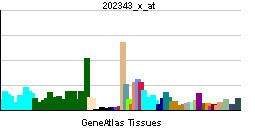Entrez 1329 | Ensembl ENSG00000135940 | |
 | ||
External IDs HomoloGene: 37538 GeneCards: COX5B | ||
Cytochrome c oxidase subunit 5B, mitochondrial is an enzyme that in humans is encoded by the COX5B gene. Cytochrome c oxidase 5B is a subunit of the cytochrome c oxidase complex, also known as Complex IV, the last enzyme in the mitochondrial electron transport chain.
Contents
Structure
The COX5B gene, located on the q arm of chromosome 2 in position 11.2, is made up of 4 exons and is 2,137 base pairs in length. The COX5B protein weighs 14 kDa and is composed of 129 amino acids. The protein is a subunit of Complex IV, which consists of 13 mitochondrial- and nuclear-encoded subunits.
Function
Cytochrome c oxidase (COX) is the terminal enzyme of the mitochondrial respiratory chain. It is a multi-subunit enzyme complex that couples the transfer of electrons from cytochrome c to molecular oxygen and contributes to a proton electrochemical gradient across the inner mitochondrial membrane to drive ATP synthesis via protonmotive force. The mitochondrially-encoded subunits perform the electron transfer of proton pumping activities. The functions of the nuclear-encoded subunits are unknown but they may play a role in the regulation and assembly of the complex.
Summary reaction:
4 Fe2+-cytochrome c + 8 H+in + O2 → 4 Fe3+-cytochrome c + 2 H2O + 4 H+outClinical significance
COX5A and COX5B are involved in the regulation of cancer cell metabolism by Bcl-2.
The Trans-activator of transcription protein (Tat) of human immunodeficiency virus (HIV) inhibits cytochrome c oxidase (COX) activity in permeabilized mitochondria isolated from both mouse and human liver, heart, and brain samples.
Interactions
COX5B has been shown to interact with Androgen receptor.
